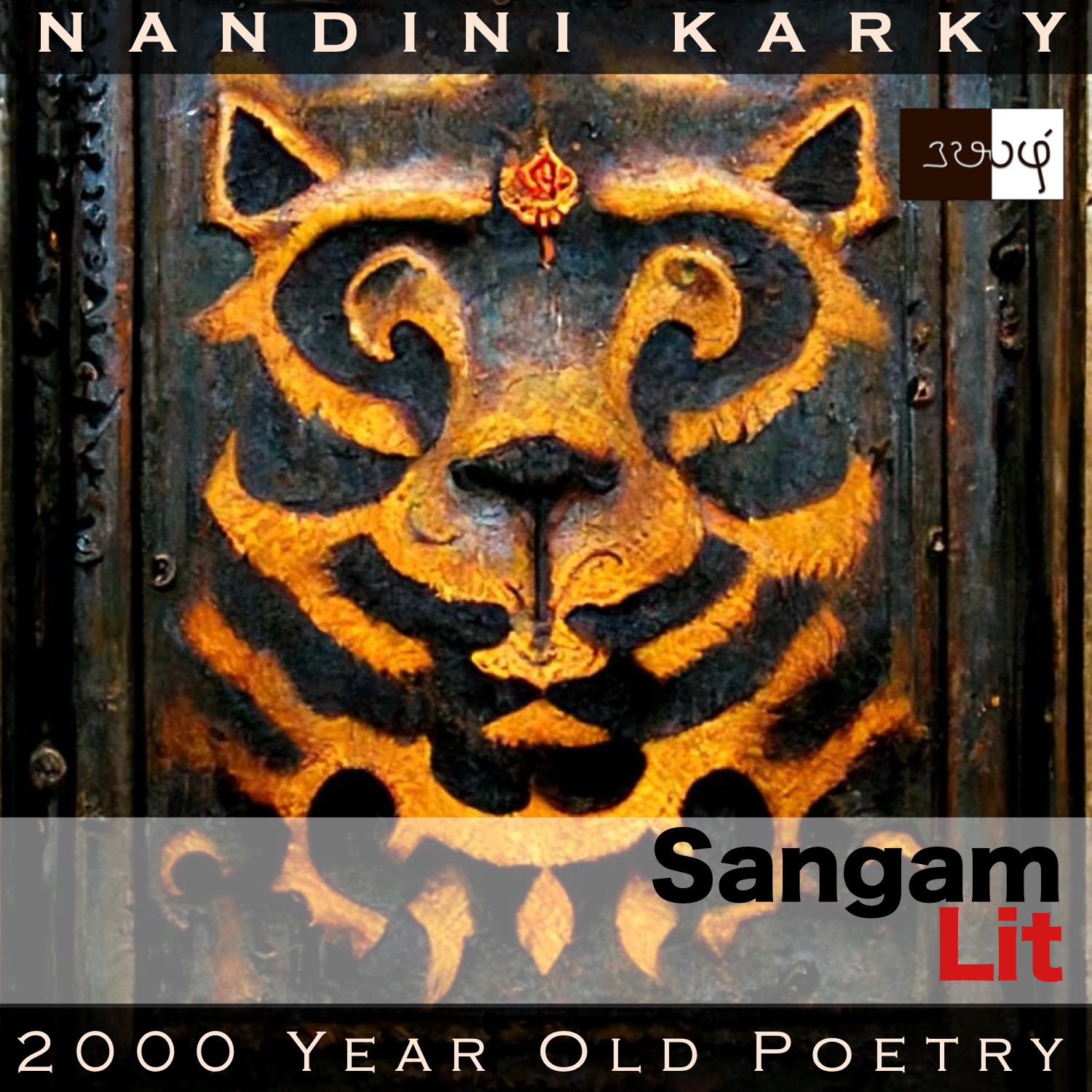Podcast: Play in new window | Download
Subscribe: Apple Podcasts | Spotify | Amazon Music | Android | iHeartRadio | Email | TuneIn | RSS | More

In this episode, we learn of a king’s victorious exploits in an enemy land, as depicted in Sangam Literary work, Puranaanooru 33, penned about the Chozha King Nalankilli, by the poet Kovoor Kizhaar. Set in the category of ‘Vaagai Thinai’ or ‘king’s victory’, the verse speaks about the luminous presence of a king at the scene of war.
கான் உறை வாழ்க்கை, கத நாய் வேட்டுவன்
மான் தசை சொரிந்த வட்டியும், ஆய்மகள்
தயிர் கொடு வந்த தசும்பும், நிறைய,
ஏரின் வாழ்நர் பேர் இல் அரிவையர்
குளக் கீழ் விளைந்த களக் கொள் வெண்ணெல்
முகந்தனர் கொடுப்ப, உகந்தனர் பெயரும்
தென்னம் பொருப்பன் நல் நாட்டுள்ளும்,
ஏழ் எயில் கதவம் எறிந்து, கைக்கொண்டு, நின்
பேழ்வாய் உழுவை பொறிக்கும் ஆற்றலை
பாடுநர் வஞ்சி பாட, படையோர்
தாது எரு மறுகின் பாசறை பொலிய,
புலராப் பச்சிலை இடை இடுபு தொடுத்த
மலரா மாலைப் பந்து கண்டன்ன
ஊன் சோற்று அமலை பாண் கடும்பு அருத்தும்
செம்மற்று அம்ம, நின் வெம் முனை இருக்கை
வல்லோன் தைஇய வரி வனப்பு உற்ற
அல்லிப் பாவை ஆடு வனப்பு ஏய்ப்ப,
காம இருவர் அல்லது, யாமத்துத்
தனி மகன் வழங்காப் பனி மலர்க் காவின்,
ஒதுக்குஇன் திணி மணல் புதுப் பூம் பள்ளி
வாயில் மாடந்தொறும் மை விடை வீழ்ப்ப,
நீ ஆங்குக் கொண்ட விழவினும் பலவே.
The patron seems to be the focus in this sorting of ‘Puranaanooru’ poems, and we see yet another song celebrating the Chozha king Nalankilli by the same poet. His words can be translated as follows:
“The hunter who lives in the jungle in the company of wild dogs brings deer meat in a bowl, and the daughter of cowherds brings curd in a pot. The women of those who live by the plough, residing in their great houses, fill both the bowl and pot to the brim with harvested white paddy grown in the fields near the ponds, and return it, making those who received it part away with joy. Such scenes are to be seen in the mountain country of the southern king. In his country, you attacked the ‘seven-doored’ fort and capturing it, you imprinted on the door, your huge-mouthed tiger symbol!
While singers render songs of such victories, your soldiers stay at encampments surrounded by pollen dust. Akin to balls of garlands with fresh buds, interwoven with undried green leaves, rice mixed with meat is savoured by the kith and kin of bards. Great indeed is your seat at that fierce battlefield!
Akin to the dancing beauty of ‘alli’ dolls, stitched with impeccable designs by the skilful craftsman, walk lovers at midnight, but never a solitary person, in that grove with dew-drenched flowers. On these pleasant sands filled with fresh flowers, you offer many a goat in sacrifice as part of the festivities. And yet, your battlefield is even lovelier than those festivities performed by you!”
Let us delve into the intricacies in this tribute! The poet mentions not anything about the king, but rather brings together, people from three different landscapes. First, he mentions a hunter who inhabits the mountainous regions of ‘Kurinji’ and talks about how he brings a vessel full of deer meat. Next, the poet turns to another cooking utensil, a pot, this time, containing curd, brought thither by the daughter of cowherds, who inhabit the forest regions of ‘Mullai’. Where have these two people from two different regions arrived at? This happens to be the ‘Marutham’ or agricultural regions, where people live with the aid of the plough, and the women living in the mansions of such regions procure the deer meat and the curd from the hunter and cowherd’s daughter, and in return, fill their containers with white paddy that was cultivated in the fields near the ponds. In these few lines, the economic dynamics of those times is vividly sketched. Although every region had something to give, we see the shift of power happening towards the agricultural homes, for that’s where the products for barter seem to culminate.
Returning, we learn that such events are taking place in the Pandya king’s land and in this region, there was a seven-tiered fort, which was famous for being unassailable. But that fort was seized by this Chozha king and his symbol of a tiger was imprinted on the entrance to that fort, the poet says. Interesting how the poet sings the praises of the enemy nation and not his patron. This is to say, even such a country with so much wealth and prosperity was snatched away by this Chozha king and brought under the reign of the tiger!
Then, the poet talks about the activities at the battle encampments of the king, pointing to us, singers who proclaim the victory of the king, and then turns to soldiers who seem at ease amidst the encampments surrounded by pollen dust. And not just that, relatives of bards can be seen relishing balls of rice and meat, akin to a garland of buds and green leaves. Such is the magnificent presence of the king at the battlefield, the poet details.
Moving on to talk about some well-crafted ‘alli’ dolls that are dancing close together, the poet places them in parallel to the intimacy of couples in the moonlight and says at these groves, filled with fine sea sand, and coated with the fall of fresh flowers, the king sacrifices goats many as part of the festivities. And even more spectacular than these festivities is the king’s presence at the battlefield, the poet concludes.
And in the last instance, there is also mention of ‘Neythal’ or coastal regions in that hint of sands and flower-filled groves. That leaves only the ‘Palai’ or drylands as unmentioned but when you think of it, wars are always described as being set in this drylands landscape, and thus, we have all five landscapes that dominate ‘Aham’ poetry making their presence felt subtly in this ‘Puram’ verse to a Chozha king!




Share your thoughts...